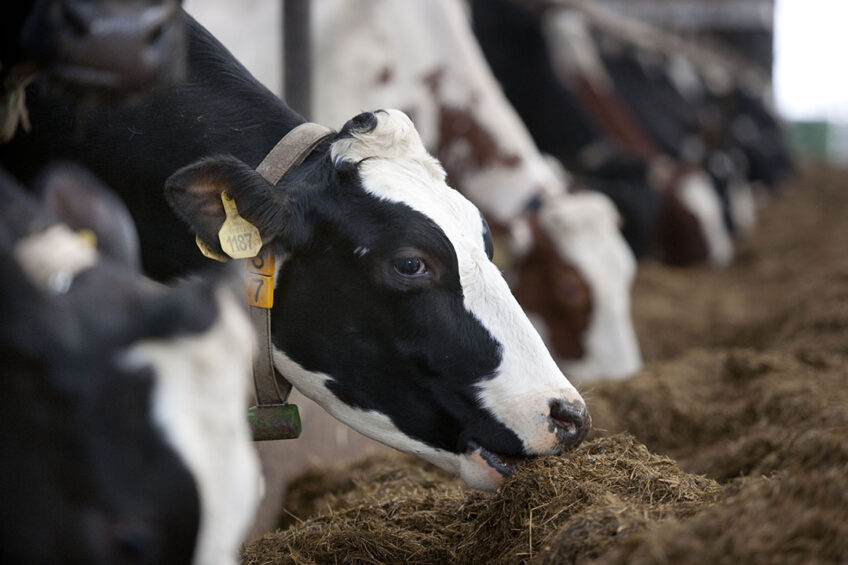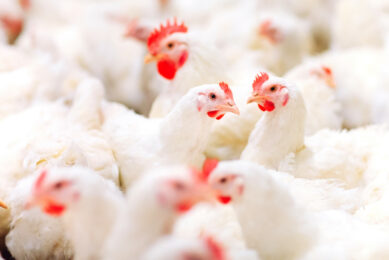Balancing for amino acids maximises performance

Over the last years tremendous efforts and research have been made to refine the protein requirements of dairy cows. Consequently, our growing understanding of cow requirements has resulted in the recognition of 2 sets of protein requirements; rumen degradable protein (RDP), and rumen undegradable protein (RUP). Besides this, metabolically the cow has specific requirements for individual amino acids (AAs) rather than metabolisable protein (MP).
Amino acids are the building blocks of milk and body proteins and considered one of the most important nutrients for dairy cows. Many of these amino acids need to be supplemented in the diet, because they can’t be synthesised enough to meet the requirements of producing cows. Therefore, these amino acids are known as essential AAs. Inadequate supply of these essential AAs can limit milk and milk protein yield; thus, they are referred to as limiting AAs. The essential AA that is present in MP in the smallest supply relative to a cow’s requirements is referred to as limiting AA. Methionine (Met) and lysine (Lys) have been recognised as the first limiting AAs, for lactating dairy cows under most feeding practices.

Intestinally available AAs are derived from 3 sources:
- microbial protein,
- RUP and
- endogenous protein.
Collectively, these protein sources are called metabolisable protein. Therefore, dairy rations should be formulated to provide MP with an AAs profile that is consistent with the AA requirements for maintenance, growth, lactation and reproduction. Rumen protected amino acids are the best way to provide the limiting amino acids. Even though these sources differ in the protection technology used (fat coating, pH sensitive coating, chemical protection or using analogues), we have to know the true bio availability of methionine and lysine of all of these supplements and to choose the most metabolisable amino acids for the price.
Benefits of balancing for amino acids
Methionine and lysine work in concert; both amino acids are necessary in diets for the best precise feeding to achieve the maximum production performance without overfeeding protein. Balancing dairy rations for AA, rather than CP%, is the state-of-the-art approach when it comes to protein nutrition. Balancing dairy rations for AA allows for more precise feeding so that cows can achieve maximum production performance without overfeeding protein. The benefits of balancing for AAs are endless if dairy nutritionist and producers are willing to adopt the concept and apply it whenever possible. The improvement in milk production, reproduction as well as animal health will outweigh any additional cost.
Achieve target formulation levels
When balancing dairy rations for AA, nutritionists are encouraged to consider the following recommendation for maximising milk components and MP utilisation.
- Diets should be formulated to maximise microbial protein synthesis, because microbial protein has an excellent profile of essential AA that matches the AA profile of milk protein.
- Maximising microbial protein can be achieved through synchronising the availability of readily fermentable carbohydrate with an adequate, but not excessive, quantity of RDP. Overfeeding RDP might exceed bacterial requirement and ammonia produced in the rumen can decrease flow of microbial protein to the small intestine.
- Balance the ration for the correct targeted levels for Lys and Met and maintain the recommended ratio of approximately 3:1 or 2.7 (depending on the ration nutritional model).
- Provide a high quality high-Lys protein supplement to achieve the recommended Lys levels in MP. However, achieving the target recommended level of Lys is becoming feasible with the recent release of the rumen protected Lys products that can be used to partially compensate for the deficiency in Lys from feedstuffs without overfeeding RUP.
- Feed rumen protected Met in the amounts needed to achieve the targeted level in MP without oversupplying total MP. It is important for the dairy nutritionist to remember that rumen protected Lys and Met are not feed additives but are essential nutrients and should be used accordingly in ration formulation to meet the optimal Lys and Met levels in MP.
Also read: Kemin launches new solutions for ruminants
Along with the choice of the most high-quality product, the choice of an experienced advisor is also important. This person/company should be able to provide constant support and act according to constantly changing market situations. Kemin Amino Acid Program is supported by data-driven researches using sophisticated models that are validated in a 3-step process:
- step 1 – in the lab;
- step 2 – in the animal and
- step 3 – in the dairy farm and industry.
Table 1 shows meta-analysis data for successful Kemin Amino Acid Program implementation (diet balanced in Met and Lys thanks to Kemin products and technical knowledge) vs. control group (no amino acid balanced diet).
Table 2 presents meta-analysis data for Kemin Lysine supplements implementation (LysiGem or LysiPearl) vs. control group (no amino acid balanced diet or only balanced for Met w/o any rumen protected source of Lys).
Conclusions
In conclusion, balancing for AAs rather than crude protein is the cutting-edge approach when it comes to protein nutrition. Adopting the concept of balancing for AAs can bring endless opportunities for maximising dairy herd profitability. With the continuous increase in feed prices, and cost of milk production, diet reformulation with low crude protein content while balancing for AAs, using rumen protected Met and Lys, can improve MP utilisation, and maximise dairy cow production. One of the greatest benefits of balancing for AAs is increasing milk and milk component yield with less RUP, at similar or lower feed cost. The increase in milk yield is more common in early lactation cows and can be of great benefit if balancing for Lys and Met are implemented already in close up period. Additionally, balancing for the first 2 limiting AAs will decrease MUN and overall nitrogen excretion, and will improve dairy cow health and reproduction.
References are available upon request.
For more information visit: www.kemin.com/aminoacidprogram
Join 13,000+ subscribers
Subscribe to our newsletter to stay updated about all the need-to-know content in the dairy sector, two times a week.










